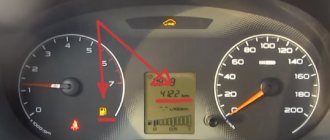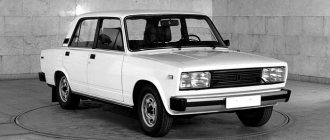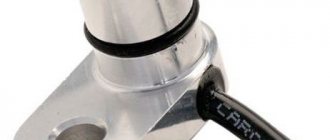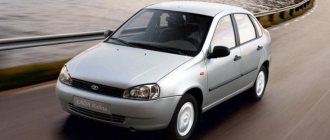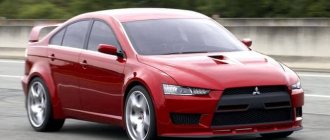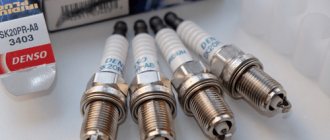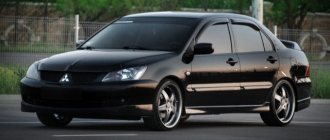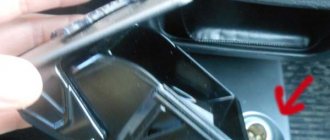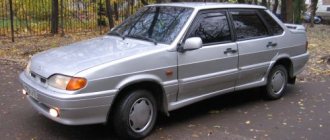Choosing gasoline in Mitsubishi Lancer 9
Mitsubishi Lancer 9 is a popular Japanese car with low fuel consumption. True, it depends on the brand and cylinder capacity of the engine used. The most popular engine installed on the Lancer 9 was the 4G15 with a volume of 1.5 liters.
There are also versions with 4G93 (1.8 liters) and 4G94 (2 liters) engines. Depending on the engine and gearbox version, the 9th Lancer can be equipped with fuel tanks with a volume of 48-50 liters:
- popular sedans of the 6th generation (second restyling) produced in 2005 are equipped with tanks with a capacity of 50 liters,
- cars of 2003 (the first restyling) received 48 liter tanks.
Mitsubishi Lancer 8th generation
The 8th generation Mitsubishi Lancer was produced from 1996 to 2003. Cars of this generation were available in sedan body type, and sometimes coupes were also available. For consumers in European countries, configurations with gasoline engines of 1.3 liters (power 69 hp) and 1.6 liters (power 120 and 124 hp) were offered.
Reviews of the real consumption of Mitsubishi Lancer VIII
- Ruslan, Makhachkala. I bought a 2003 Mitsubishi Lancer, 1.6 liter engine. Despite the small volume, I am completely satisfied with the car, because I am not a fan of driving. And for a calm, measured ride it is quite enough. Even the fact that I didn’t buy it new did not in any way affect its driving performance. Consumption for a sedan is quite normal - up to 10 liters.
- Igor, Yaroslavl. At the time of choosing a car, I did not expect more than a budget option. And the 2001 Mitsubishi Lancer fits perfectly into my calculations. The fact that the year of manufacture is old does not harm the car. Good ride, dynamics, comfortable fit. Ten liters of gasoline are enough for 170-180 km. Engine 1.6 l.
- Oleg, Syzran. I have a 2002 Mitsubishi Lancer, 1.6 liter engine, automatic transmission. The car is decent, but there are a lot of shortcomings. Sometimes it jerks when changing gears, the power is not enough for me. But fuel consumption is quite economical, at low speeds about 6 liters.
- Vladislav, Perm. My father gave me a 2000 Mitsubishi Lancer, 1.3 liter. Everyone already knows about the qualities of the “Japanese”; I measured fuel consumption. On good roads, consumption is around 6-6.5 liters, unfortunately, there are few of them. On normal roads it takes up to 10-11 liters of gasoline.
- Vladimir, Kostroma. I bought the 2001 Mitsubishi Lancer new, and now I have driven more than 270 thousand km. So far it is undergoing routine scheduled maintenance; nothing else has been done to the car. Reliable, unbreakable, unpretentious machine. Fuel consumption is about 8-9 liters on average. Engine 1.3 l.
- Andrey, Irkutsk. Before the Mitsubishi Lancer, I had a two-liter Honda Civic. Of course, there is a difference, but the power of the 1.6-liter Lancer is quite enough for me. It behaves well on the road and does not consume much - from 8 liters outside the city to 11-12 liters in the city. Model 1999 release.
- Gregory, Vologda. I've been driving a Mitsubishi Lancer 2000 for five years now. During all this time I hardly climbed under the hood. Consumables and oil - that's all the replacement. The car is indestructible, drives in any weather. In the city I consume up to 12 liters, on the highway 6-8 liters, depending on the quality of the road surface.
Fuel consumption with 4G15 engine
The popular internal combustion engine on Japanese Lancers is 4G15 with a working cylinder capacity of 1.486 liters. This is a classic 4-cylinder engine with 12 valves, which is distinguished by its unpretentiousness to gasoline. It works freely with AI-92 and AI-95 gasoline, and fuel consumption, according to various sources, varies from 7.5 to 8.5 l/100 km in the city; from 5.5 to 6 l/100 km – on the highway.
On various automobile forums, owners of Lancers with 4G15 engines complain about increased gas consumption. For many drivers, it exceeds 10 liters per hundred and even reaches 11-1.5 l/100 km in city driving conditions in the warm season.
In winter, consumption increases to 13 l/100 km. Some owners have a car with this engine that consumes 25 liters per 100 km, but in this case there is a problem. On average, 9-11 liters per 100 km in the city is a normal figure when we are talking about a Lancer based on the 4G15 engine.
Fuel consumption Mitsubishi Lancer IX 1.6i MT (98 hp)
Official data reflects the fuel consumption provided by the manufacturer of the Mitsubishi Lancer IX 1.6i MT (98 hp) , it is indicated in the car’s service book, and can also be found on the manufacturer’s official website. Real fuel consumption data is based on the testimony of Mitsubishi Lancer IX 1.6i MT (98 hp) who left fuel consumption information on our website.
If you are the owner of a Mitsubishi Lancer IX 1.6i MT (98 hp) , and you know at least some data about the fuel consumption of your car, then you can influence the statistics below. It is possible that your data will differ from the given vehicle fuel consumption figures, in which case we ask you to immediately enter this information on the website to correct and update it. The more owners add their data on the real fuel consumption of their car, the more accurate the information obtained about the true fuel consumption of a particular car will be.
The table below shows average fuel consumption values for the Mitsubishi Lancer IX 1.6i MT (98 hp) . Next to each value, the amount of data on which the average fuel consumption is calculated is indicated (i.e., this is the number of people who filled out the information on the site). The higher this number, the more reliable the data obtained.
| # | Locality | Region | Consumption | Qty |
| Zaporozhye | Zaporozhye region | 7.93 | 3 | |
| Miass | Chelyabinsk region | 8.00 | 1 | |
| Yaroslavl | Yaroslavl region | 8.00 | 1 | |
| Eagle | Oryol Region | 8.00 | 1 | |
| Kamensk-Uralsky | Sverdlovsk region | 8.00 | 1 | |
| Krasnoyarsk | Krasnoyarsk region | 8.30 | 1 | |
| Prokopyevsk | Kemerovo region | 8.50 | 2 | |
| Poltava | Poltava region | 8.50 | 1 | |
| Stavropol | Stavropol region | 8.50 | 2 | |
| Tolyatti | Samara Region | 8.57 | 3 | |
| Zhytomyr | Zhytomyr Oblast | 9.00 | 1 | |
| Odessa | Odessa region | 9.00 | 2 | |
| Sevastopol | Sevastopol | 9.00 | 2 | |
| Kostroma | Kostroma region | 9.00 | 1 | |
| Kursk | Kursk region | 9.00 | 3 | |
| Kirov | Kirov region | 9.00 | 1 | |
| Lipetsk | Lipetsk region | 9.00 | 1 | |
| Dnepropetrovsk | Dnepropetrovsk region | 9.00 | 3 | |
| Stakhanov | Lugansk region | 9.00 | 1 | |
| Izhevsk | Republic of Udmurtia | 9.00 | 2 | |
| Odintsovo | Moscow region | 9.00 | 1 | |
| Tambov | Tambov Region | 9.00 | 1 | |
| Novosibirsk | Novosibirsk region | 9.00 | 1 | |
| Peaceful | Arhangelsk region | 9.00 | 1 | |
| Dubna | Moscow region | 9.00 | 1 | |
| Balakhna | Nizhny Novgorod Region | 9.00 | 1 | |
| Khanty-Mansiysk | Khanty-Mansiysk Autonomous Okrug | 9.00 | 1 | |
| Saratov | Saratov region | 9.08 | 6 | |
| Kaluga | Kaluga region | 9.10 | 2 | |
| Mezhdurechensk | Kemerovo region | 9.25 | 1 | |
| Voronezh | Voronezh region | 9.25 | 2 | |
| Bryansk | Bryansk region | 9.30 | 1 | |
| Petrozavodsk | Republic of Karelia | 9.30 | 5 | |
| Smolensk | Smolensk region | 9.40 | 2 | |
| Kazan | Republic of Tatarstan | 9.42 | 6 | |
| Kyiv | Kyiv | 9.49 | 16 | |
| Kharkiv | Kharkov region | 9.50 | 5 | |
| Podolsk | Moscow region | 9.50 | 1 | |
| Dneprodzerzhinsk | Dnepropetrovsk region | 9.50 | 1 | |
| Samara | Samara Region | 9.50 | 3 | |
| Vinnitsa | Vinnytsia region | 9.50 | 2 | |
| Vladimir | Vladimir region | 9.50 | 3 | |
| Krasnodar | Krasnodar region | 9.54 | 7 | |
| Nizhnekamsk | Republic of Tatarstan | 9.55 | 2 | |
| Ufa | Republic of Bashkortostan | 9.59 | 6 | |
| Pskov | Pskov region | 9.60 | 3 | |
| Novocheboksarsk | Chuvash Republic | 9.80 | 1 | |
| Moscow | Moscow | 9.89 | 22 | |
| Saint Petersburg | Saint Petersburg | 9.92 | 11 | |
| Irkutsk | Irkutsk region | 10.00 | 3 | |
| Belgorod | Belgorod region | 10.00 | 1 | |
| Vladikavkaz | Republic of North Ossetia (Alania) | 10.00 | 2 | |
| Nikolaev | Nikolaevkskaya area | 10.00 | 1 | |
| Nizhny Novgorod | Nizhny Novgorod Region | 10.00 | 6 | |
| Dedovsk | Moscow region | 10.00 | 1 | |
| Orenburg | Orenburg region | 10.00 | 4 | |
| Yoshkar-Ola | Mari El Republic | 10.00 | 1 | |
| Armavir | Krasnodar region | 10.00 | 1 | |
| Ternopil | Ternopil region | 10.00 | 1 | |
| Tula | Tula region | 10.00 | 2 | |
| Surgut | Khanty-Mansiysk Autonomous Okrug | 10.00 | 2 | |
| Kemerovo | Kemerovo region | 10.00 | 1 | |
| Ulyanovsk | Ulyanovsk region | 10.17 | 3 | |
| Velikiy Novgorod | Novgorod region | 10.25 | 2 | |
| Chelyabinsk | Chelyabinsk region | 10.25 | 4 | |
| Cheboksary | Chuvash Republic | 10.27 | 4 | |
| Ivano-Frankivsk | Ivano-Frankivsk region | 10.40 | 5 | |
| Lviv | Lviv region | 10.40 | 2 | |
| Rostov-on-Don | Rostov region | 10.50 | 5 | |
| Tver | Tver region | 10.50 | 2 | |
| Ryazan | Ryazan Oblast | 10.66 | 5 | |
| Nizhnevartovsk | Khanty-Mansiysk Autonomous Okrug | 11.00 | 1 | |
| Tyumen | Tyumen region | 11.00 | 2 | |
| Khimki | Moscow region | 11.00 | 1 | |
| Tomsk | Tomsk region | 11.00 | 1 | |
| Ekaterinburg | Sverdlovsk region | 11.00 | 3 | |
| Permian | Perm region | 12.00 | 1 | |
| Cherkasy | Cherkasy region | 12.00 | 1 | |
| Omsk | Omsk region | 12.50 | 2 | |
| Kirovograd | Kirovograd region | 13.00 | 1 |
The table below shows in sufficient detail the dependence of fuel consumption on the speed of the Mitsubishi Lancer IX 1.6i MT (98 hp) on the highway. Each speed value corresponds to a certain fuel consumption. If the Mitsubishi Lancer IX 1.6i MT (98 hp) has data for several fuel types, they will be averaged and shown in the first row of the table.
The popularity index shows how popular a given car is on this site, namely, the percentage of added information about the fuel consumption of Mitsubishi Lancer IX 1.6i MT (98 hp) to the fuel consumption data of the car that has the maximum amount of added data from users . The higher this value, the more popular the car is on this project.
The position in the fuel economy car rankings for the Mitsubishi Lancer IX 1.6i MT (98 hp) is calculated based on average fuel consumption data among all cars for which information is available on the site. The lower the fuel consumption, the higher the position in the ranking of economical cars. Cars with the same fuel consumption occupy the same position.
Mitsubishi Lancer 9 with ICE 4G92 and 4G93
Old 5th generation models from 1992-2000 were equipped with 1.6-liter 4-cylinder 4G92 engines. According to owner reviews, gasoline consumption on this engine is 6-7 l/100 km on the highway, 11-12 l/100 in the city. In the combined cycle it takes about 8-9 liters per hundred, which is an acceptable value. The differences from version 4G15 are minimal or non-existent.
4G93 engines were installed on 6th generation Lancers. They are 1.8-liter power units producing 110 hp. (atmospheric) and 150 hp. (with turbine). Essentially, these engines are the same 1.5-liter internal combustion engines, but with a bored out cylinder block and larger pistons in diameter.
It is recommended to fill them with AI-95 and AI-98 gasoline, but AI-92 is also allowed. Note that although the Japanese indicate in the specifications gasoline with an octane rating of 92 as acceptable for use on 4G93, it is undesirable to pour it into the tank due to the fact that in Russia things are worse with fuel quality control than in European countries, and even more so in Japan.
According to reviews from car owners, standard gasoline consumption on the 4G93 ranges from 8 to 9 liters per 100 km in the city, 6-7 liters on the highway. As with any other engines, there are also problems associated with the “guzzling” of gasoline. On some Lancers it is 15-16 liters per hundred. The causes of these problems can be very diverse - they can be determined during diagnosis.
Mitsubishi Lancer engines. Official fuel consumption per 100 km.
Generation 7 (1995-2000)
- 1.3, 88 l. p., manual/automatic, front
- 1.3, 75 l. p., manual, front, 12.5 sec to 100 km/h, 9.2/5.5 l per 100 km
- 1.3, 75 l. p.s., automatic, front, 15.8 sec to 100 km/h, 10.6/6.5 l per 100 km
- 1.5, 94 l. p., automatic/mechanical, front
- 1.5, 110 l. p., manual/automatic, front/full
- 1.6, 175 l. p., manual/automatic, front
- 1.8, 135 l. p., automatic, front
- 1.8, 125 l. p., manual/automatic, front
- 1.8, 205 l. p., manual/automatic, front/full, 11.9 sec to 100 km/h
Generation 9 (2000-2005)
- 1.3, 82 l. p., manual/automatic, front, 13.7 sec to 100 km/h, 8.5/5.3 l per 100 km
- 1.5, 91 l. p., variator/mechanics, front/full
- 1.5, 100 l. p., variator/mechanics, front/full
- 1.6, 98 l. p., manual/automatic, front, 8.8/5.5 – 10.3/6.4 l per 100 km, 11.8-13.6 sec to 100 km/h
- 1.8, 114 l. p., variator, front
- 1.8, 130 l. p., variator, full/front
- 1.8, 165 l. p., automatic, front
- 2.0, 120 l. p., manual/automatic, front
- 2.0, 135 l. p., manual/variable, front, 9.6 sec to 100 km/h, 11.7/6.5 l per 100 km
- 2.0, 135 l. p.s., automatic, front, 12 sec to 100 km/h, 12.6/6.9 l per 100 km
- 2.4, 162 l. p., manual/automatic, front, 10.7/8.4 l per 100 km
Restyling generation 9 (2005-2010)
- 1.3, 82 l. p., manual/automatic, front, 13.7 sec to 100 km/h, 8.5/5.3 l per 100 km
- 1.5, 91 l. p., variator/mechanics, front/full
- 1.5, 100 l. p., variator/mechanics, front/full
- 1.6, 98 l. p., manual/automatic, front, 8.8/5.5 – 10.3/6.4 l per 100 km, 11.8-13.6 sec to 100 km/h
- 1.8, 114 l. p., variator, front
- 1.8, 130 l. p., variator, full/front
- 1.8, 165 l. p., automatic, front
- 2.0, 120 l. p., manual/automatic, front
- 2.0, 135 l. p., manual/variable, front, 9.6 sec to 100 km/h, 11.7/6.5 l per 100 km
- 2.0, 135 l. p.s., automatic, front, 12 sec to 100 km/h, 12.6/6.9 l per 100 km
- 2.4, 162 l. p., manual/automatic, front, 10.7/8.4 l per 100 km
Generation 10 (2007-2010)
- 1.5, 109 l. s.. manual, front, 11.6 sec to 100 km/h, 8.2/5.4 l per 100 km
- 1.5, 109 l. p.s., automatic, front, 14.3 sec to 100 km/h, 8.9/6 l per 100 km
- 1.6, 117 l. p.s., automatic, front, 14 sec to 100 km/h, 9.1/5.8 l per 100 km
- 1.6, 117 l. p., manual, front, 10.8 sec to 100 km/h, 7.8/5 l per 100 km
- 1.8, 143 l. p., variator, front, 11.2 sec to 100 km/h, 10.9/6.2 l per 100 km
- 1.8, 143 l. p., manual, front, 9.8 sec to 100 km/h, 10.4/6.1 l per 100 km
- 2.0, 150 l. sec., CVT, full, 11.4 sec to 100 km/h, 12.1/6.8 l per 100 km
- 2.0, 150 l. pp., manual, full, 9.8 sec to 100 km/h, 11.2/6.9 l per 100 km
- 2.4, 168 l. p., manual, front, 11.2/8.4 l per 100 km
- 2.0, 140 l. p., manual/variable, front, 9.6 sec to 100 km/h, 8.2/4.9 l per 100 km
Restyling generation 10 (2011-2015)
- 1.6, 117 l. p., manual, front, 10.8 sec to 100 km/h, 7.8/5 l per 100 km
- 1.8, 140 l. p., variator, front, 11.4 sec to 100 km/h, 10.8/6.1 l per 100 km
Second restyling of generation 10 (2015-present)
- 2.0, 148 l. p., manual, front, 9.8/6.9 l per 100 km
- 2.0, 148 l. p., variator, front, 8.7/6.7 l per 100 km
- 2.4, 168 l. p., manual, front, 10.7/7.6 l per 100 km
- 2.4, 168 l. p., variator, front, 9.8/7.6 l per 100 km
- 2.4, 168 l. p.s., CVT, full, 10.2/7.6 l per 100 km
Source: automera.com
Reasons for increased gasoline consumption
Not a single service station technician will tell you why gasoline is being wasted without preliminary diagnostics. The problem may lie in the internal combustion engine itself, or in the fuel supply system, injector, carburetor (9th Lancers can have one of two power systems).
Often, owners simply operate engines incorrectly, which leads to increased consumption:
- constant stops in the city, sudden starts,
- intensive acceleration when overtaking,
- driving at consistently high speeds, using winter tires in the warm season (and vice versa),
- deflated wheels,
- untimely replacement of oil and other consumables - this causes increased fuel consumption.
Technical problems faced by Mitsubishi Lancer 9 owners:
- Clogged injectors, which leads to incorrect injection. The solution is to clean them or replace them.
- Incorrect operation of the fuel pump, due to which the pressure in the fuel system “jumps”. This results in an incorrectly proportioned fuel-air mixture.
- Exhaust gas recirculation (EGR) valve clogged. Through it, part of the exhaust gases is returned back to the engine, and this operation is controlled by the ECU, which opens and closes the valve. Over time, soot accumulates on it, and this leads to jamming of the valve. Then, during the entire operating time, a “porridge” of air, exhaust gases, and gasoline enters the combustion chamber - such a mixture is ineffective, and this leads to increased consumption. The solution is to clean the valve from burning and soot. This operation is even prescribed in the technical passport for some cars as a mandatory maintenance measure.
- Oil of incorrect viscosity or poor quality, which leads to increased friction between the pistons and cylinder walls.
- Oxygen sensor (lambda probe). Some Lancer owners overcome overspending only after replacing the lambda probe. This sensor determines the amount of oxygen in the exhaust and, based on this information, the ECU optimizes the mixture composition, supplying more or less fuel to the cylinders. Incorrect operation of the oxygen sensor increases the “appetite” of the engine.
Increased oil consumption due to engine valve seals and wear of guide bushings
Valve seals in engines lose elasticity over time and harden over long runs. On one engine they can last only 50 thousand kilometers, but on another they have to be changed after 150 thousand kilometers. It is worth noting that in conditions of high mileage of the car, replacing oil seals may not solve the problem of high lubricant consumption.
Oil seals can wear out due to overheating, both internal (invisible) and visible, which is detected by a temperature sensor. In the latter case, the problem lies in the failure of the cooling system, and in the first it is very difficult to diagnose the malfunction, although it is usually associated with poor fuel quality. When fuel is incompletely burned, processed products form deposits and soot inside the combustion chamber, as a result of which the walls of the motor lose thermal conductivity and also provoke overheating, which is not detected by the temperature sensor.
Replacing valve stem seals with your own hands without replacing the valve guides and troubleshooting may not give the necessary results and the Mitsubishi Lancer 9 engine will continue to consume oil. Considering the pumping effect that occurs when installing oil seals on worn guide bushings, oil consumption may even increase.
Versions and configurations
Lancer 9th generation combines many useful functions and qualities. The car has two popular versions - 1.3-liter and 1.6-liter. The sports modification, equipped with a 2-liter unit, is designed for amateurs. “Russian” Lancer 9 was also offered in three versions: 1.3, 1.6 and 2.0 – all with gasoline internal combustion engines. Both sedans and station wagons sold well.
Sedans
Regarding the sedan trim levels, the following picture emerges:
- The 82-horsepower 1.3-liter engine was equipped only with the Invite-MT . The engine brand was called 4G13, and the body brand was CS1A. Years of production: from August 2003 to May 2009. Wheel drive is front-wheel drive.
- The Invite-MT package was also equipped with a 1.6-liter internal combustion engine in the same body brand. Lancer 9 of this version accelerated to 100 km/h in 13.6 seconds. Fuel consumption – 6.7 liters.
- A 98-horsepower 1.6-liter power unit was equipped with a package called Invite-MT Special , released from April 2007 to June 2007. The car developed a speed of 183 km/h, differed from other versions (for example, Invite Plus ) in low consumption - 6.7 l/100 km versus 7.9 l/100 km - a noticeable difference. The gearbox is mechanical with 5 speeds, when the standard configurations of the Invite 1.6 were equipped with a 4-speed manual transmission.
- The same engine was installed on the Invite Plus with a manual transmission, and on the AT and AT-plus with an automatic transmission. A model with a 4-speed automatic transmission, produced from March 2006 to May 2009, consumed 7.9 liters of fuel per 100 km. Considering the presence of an automatic transmission, this consumption can be considered not very high.
- The Instyle-MT and Instyle-AT configurations were equipped with a 1.6-liter engine. Both versions were produced from August 2003 to May 2009. The consumption of the version equipped with a manual transmission was 6.7 l/100 km, and the version with an automatic transmission was 7.9 l/100 km. The 5-speed manual accelerated to 100 km/h in 11.8 seconds, and the automatic in 13.6 seconds. It is noteworthy that with a manual it was possible to accelerate to 183 km/h, and with an automatic – only up to 176 km/h.
- The top trim levels Intens-MT and Intens-AT were equipped with a larger 2.0 liter 4G63 engine. Intens-MT was published from August 2003 to May 2009. Intens-AT - from March 2006 to May 2009. The consumption of the manual version is 8.4 l/100 km, the automatic version is 9 liters. The automatic transmission version was also inferior in maximum speed: Lancer 9 with a manual transmission could accelerate to 204 km/h, and to 187 km/h with an automatic transmission.
Thus, three brands of engines 4G13, 4G18 and 4G63 were installed on the 9th generation Lancer. The latter is the destiny of the top Intens configurations.
The engines also had different power levels: 4G13 developed 82 hp. pp., 4G18 – 98 l. s, and 4G63 – 135 hp. With.
Weak Lancer 9 engines are either naturally aspirated from the Orion or Sirius line. Strong 4G6 - created using Maivek technology, which ensures synchronous operation of the cylinders at low and high speeds.
Mitsubishi Lancer 9 technical specifications 2.0 Intense-AT
| Release period | March 2006 – May 2009 |
| checkpoint | Automatic 4 |
| Engine capacity, cc | 1997 |
| Body brand | CS1A |
| Acceleration time 0-100 km/h, s | 12 |
| Ground clearance (ride height), mm | 155 |
| Maximum speed, km/h | 187 |
| Body dimensions (L x W x H), mm | 4535 x 1715 x 1435 |
| Wheelbase, mm | 2600 |
| Permissible total weight, kg | 1770 |
| Fuel tank volume, l | 50 |
| Engine make | 4G63 |
| Fuel consumption in the combined cycle, l/100 km | 9 |
How much does the subcompact version consume?
If you are one of those who prefer to save on servicing a Lancer, purchase a modest and low-power 1.3 liter version with an engine of just 83 horsepower. Statistics for this configuration indicate that, according to official data, again, a car with such an engine should “eat” a maximum of 8.6 liters. Having turned to the owners for feedback, we find that in reality it comes out to 9.63 when driving around the city. If you have your own excellent data, write to us.
With this we will say goodbye, friends. There are many other useful discussions ahead of us regarding fuel consumption of other car brands, and not only. Subscribe to the blog and stay up to date with events. Bye!
Body
The 3-volume four-door sedan is usually classified as class “C”. The car's creators paid special attention to safety, taking into account the failures of the previous Lancer, whose sales partially failed due to this parameter. As a result, Lancer 9 received a unique body, modernized at several points. In addition, it was additionally reinforced with stiffeners in the doors and sidewalls.
The Lancer 9 body is also good in terms of reliability against through corrosion. MMC gave a 12-year warranty on the hardware.
For the sake of the same safety, the front, rear and side body panels of the car received a programmed degree of deformation. During accidents and collisions, they deformed, absorbing the energy of the shock wave and preventing it from penetrating into the cabin.
As for the dimensions, the Lancer 9 also falls into the golf class. It is both compact and quite spacious. The length of the sedan body is 4535 mm, width – 1715 mm, and height – 1445 mm. The ground clearance is not small - 165 mm.
Dimensions of trunks of station wagon and sedan
Read more about the Lancer 9 body here .
Salon
Inside, the sedan, and especially the station wagon, is practical and meets the rules for family cars. For example, the trunk size is almost the best in the class - 430 liters.
Salon Lancer 9
Everything in the cabin is done so practically that it can even be called somewhat ascetic. This is especially true for the interior of the “Russian” versions, which looks somewhat gray compared to the “Statov” versions.
In the “American” and “Asian” versions, the multimedia system with an LCD monitor and beautiful wood trim are impressive. And the Momo steering wheel, electric sunroof and leather interior are the height of sophistication. Such models justifiably rule the secondary market. You can recognize them by their nameplates: Raliart, Mirage or Virage.
RallyArt grille
In general, thanks to direct delivery from Japan and larger sizes compared to the previous Lancer 8, Lancer 9 (or the restyled Cedia) fell in love with Russians. The owners were impressed by the rear sofa, on which even very tall and obese people felt comfortable. True, there should have been no more than two of them, otherwise it would become crowded. The front passenger seat was also unimpressive due to the sharply sloping ceiling.
The 2005 restyling introduced virtually nothing new. Apart from the redesigned radiator grille and upgraded bumper. There was also climate control and a new leather steering wheel.
Lancer 9 had the best demand on the Russian market in 2005-2007. There is no shortage of these models today. Less common are pre-restyling modifications produced in 2003-2004. There are even fewer cars from the late period - 2008-2009. Despite the technical advantage of the station wagon, the sedan dominates the market. As for engines, the 98-horsepower naturally-aspirated 1.6-liter engine is more in demand. Out of the box - manual transmission.
Approximate price for Lancer 9 on the secondary market of the Russian Federation
| Year of issue | Average price, rub. | Average declared mileage, km |
| 2003 | 230000 | 160000 |
| 2004 | 254000 | 152000 |
| 2005 | 272000 | 135000 |
| 2006 | 296000 | 133000 |
| 2007 | 343000 | 102000 |
| 2008 | 398000 | 92000 |
| 2009 | 402000 | 78000 |
Finally, a recommendation in terms of choice: a station wagon is more suitable for a family of several people, while a sedan can be used as a taxi.
Source: info-mitsubishi.ru
Mitsubishi Lancer 9 fuel consumption
Conversations on general automotive topics among all forum participants
Messages: 15 Joined: Nov 26, 2015 1:05 pm
| Rating: 15 |
| Reputation: 0 |
Thanked: 3 times
Lancer 9 1.6 automatic transmission, high consumption, help needed!
Posted by ryan7 » Nov 26, 2015 1:23 pm
Messages: 1995 Registered: Dec 10, 2008, 00:00 Auto: Classic : Awards: 1
| Rating: 11 355 |
| Reputation: +11 |
Thanked: 30 times Thanked: 165 times
Lancer 9 1.6 automatic transmission, high consumption, help needed!
Post by Soder » 26 Nov 2015, 13:51
Messages: 4324 Registered: May 29, 2008, 00:00 : Awards: 1
| Rating: 12 977 |
| Reputation: +24 |
Thanked: 275 times Thanked: 123 times
Lancer 9 1.6 automatic transmission, high consumption, help needed!
Post by Vitek » 26 Nov 2015, 14:23
Messages: 15 Joined: Nov 26, 2015 1:05 pm
| Rating: 15 |
| Reputation: 0 |
Thanked: 3 times
Lancer 9 1.6 automatic transmission, high consumption, help needed!
Post by ryan7 » Nov 26, 2015 2:28 pm
Messages: 10 Registered: Jan 16, 2011, 00:00
| Rating: 10 |
| Reputation: 0 |
Lancer 9 1.6 automatic transmission, high consumption, help needed!
Post by evg_b » 26 Nov 2015, 14:43
yeah that's a LOT.
For example, I have a Nissan Note 1.6 automatic 4-speed. And I will say that even in wild frosts with warm-ups and short trips to work and back I didn’t climb above 14-15.
Well, now it’s 11-12 consumption
Messages: 4 Registered: Apr 08, 2008, 00:00 : Awards: 1
| Rating: 4 |
| Reputation: 0 |
Thanked: 3 times
Lancer 9 1.6 automatic transmission, high consumption, help needed!
Post by sana389 » 26 Nov 2015, 17:18
Messages: 33 Registered: Jul 26, 2010, 00:00
| Rating: 1 033 |
| Reputation: 0 |
Lancer 9 1.6 automatic transmission, high consumption, help needed!
Post by dinis » 26 Nov 2015, 18:13
Messages: 15 Joined: Nov 26, 2015 1:05 pm
| Rating: 15 |
| Reputation: 0 |
Thanked: 3 times
Lancer 9 1.6 automatic transmission, high consumption, help needed!
Post by ryan7 » Nov 26, 2015 6:29 pm
Messages: 33 Registered: Jul 26, 2010, 00:00
| Rating: 1 033 |
| Reputation: 0 |
Lancer 9 1.6 automatic transmission, high consumption, help needed!
Post by dinis » 26 Nov 2015, 18:55
I don’t know the fuel consumption on gasoline, but the car consumes at least 0.5 liters when warming up
Sent after 1 minute 41 seconds: in short, don’t worry about everything going smoothly with your car
| Rating: 6 657 |
| Reputation: +12 |
Thanked: 9 times Thanked: 70 times
Lancer 9 1.6 automatic transmission, high consumption, help needed!
Posted by bluebird1992 » Nov 26, 2015 7:17 pm
Their consumption in winter is 12 liters with plugs.
Sent after 48 seconds: look at the throttle, they have a disease with them, increased speed, it may eat
Sent after 1 minute 8 seconds: my mileage is 130, look at the handle and steering wheel, ideally)) I took 49 thousand problems with this car, I don’t know, reliable friend.
Messages: 407 Registered: Jan 10, 2011, 00:00 From: Tyumen Experience: since - 1998
| Rating: 1 257 |
| Reputation: 0 |
Thanked: 17 times
Lancer 9 1.6 automatic transmission, high consumption, help needed!
Post by VL101 » 26 Nov 2015, 19:42
Messages: 15 Joined: Nov 26, 2015 1:05 pm
| Rating: 15 |
| Reputation: 0 |
Thanked: 3 times
Lancer 9 1.6 automatic transmission, high consumption, help needed!
Post by ryan7 » Nov 26, 2015, 8:18 pm
Messages: 10 Registered: 06 Jul 2014, 00:00
| Rating: 10 |
| Reputation: 0 |
Lancer 9 1.6 automatic transmission, high consumption, help needed!
Post by nikolvie » Nov 26, 2015, 10:18 pm
Messages: 3863 Registered: Sep 26, 2006, 00:00 From: Tyumen : Awards: 1
| Rating: 6 813 |
| Reputation: +7 |
Thanked: 29 times Thanked: 45 times
Lancer 9 1.6 automatic transmission, high consumption, help needed!
Post by Explorer » Nov 26, 2015 10:28 pm
Messages: 142 Registered: July 02, 2008, 00:00 From: we are all from the same place Experience: since 1996 Car: Kia Sportage KM : Awards: 1
| Rating: 1 392 |
| Reputation: +3 |
Thanked: 1 time Thanked: 19 times
